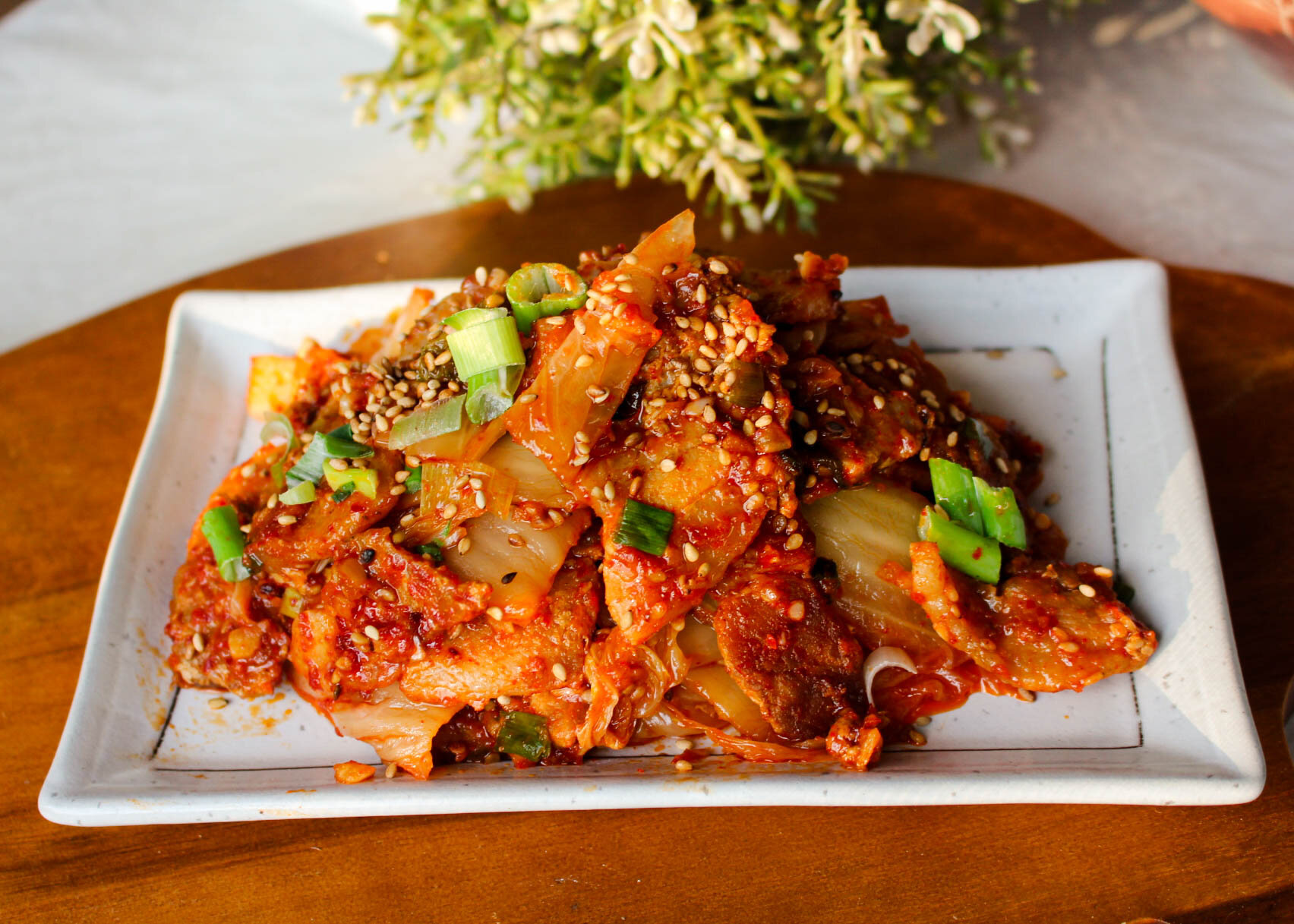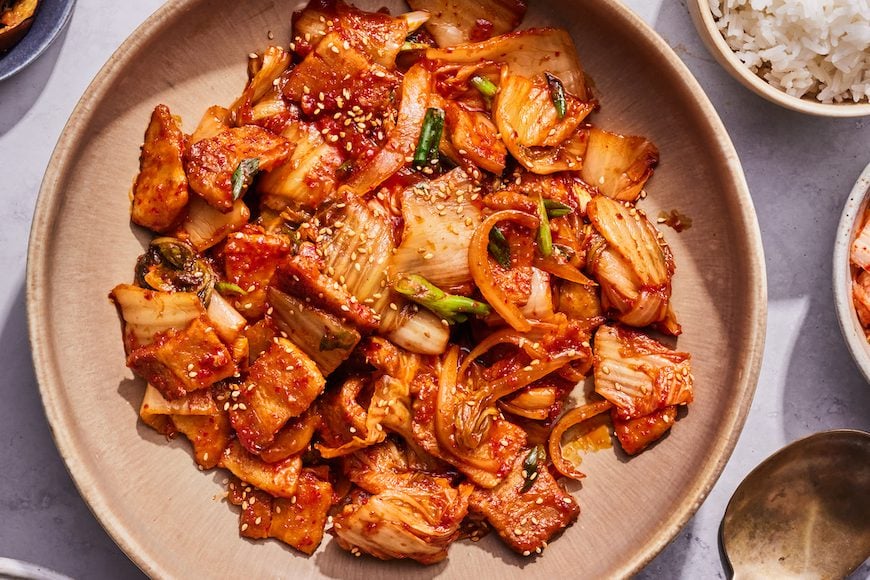Korean cuisine is celebrated worldwide for its bold flavors, vibrant colors, and harmonious balance of ingredients. Among the plethora of mouthwatering dishes that grace Korean dining tables, one stands out for its fiery appeal and irresistible taste – Korean stir-fried spicy pork, known as “dwaeji bulgogi” or “jeyuk bokkeum.” This iconic dish captures the essence of Korean culinary traditions with its tender slices of pork, marinated in a spicy, savory sauce, and stir-fried to perfection with an array of vegetables. Join me on a culinary journey as we delve into the intricacies of preparing and savoring this beloved Korean favorite.
The Origins of Korean Stir-Fried Spicy Pork:
Korean stir-fried spicy pork has a rich history rooted in Korean culinary heritage. Bulgogi, which translates to “fire meat,” is a traditional Korean dish consisting of thinly sliced beef or pork marinated in a sweet and savory sauce. Over time, variations of bulgogi emerged, each with its own unique twist on the classic recipe. Stir-fried spicy pork, or dwaeji bulgogi, is one such variation that adds a fiery kick to the beloved dish, making it a favorite among spice enthusiasts and food lovers alike.

The Preparation Process:
The key to creating the perfect Korean stir-fried spicy pork lies in the careful balance of flavors and textures. The process begins with selecting the right cut of pork, typically pork shoulder or pork belly, which is then thinly sliced to ensure quick and even cooking. The pork is then marinated in a flavorful mixture of ingredients, including gochujang (Korean chili paste), gochugaru (Korean chili flakes), soy sauce, sesame oil, garlic, ginger, and honey or sugar for sweetness.
Marinating the pork allows the meat to absorb the bold flavors of the marinade, resulting in a tender and succulent dish bursting with taste. For an authentic touch, some recipes may also include additional ingredients such as mirin (rice wine) or rice vinegar to enhance the complexity of the marinade.
Once the pork has been marinated to perfection, it’s time to stir-fry it to savory perfection. In a hot skillet or wok, the marinated pork is cooked until caramelized and slightly charred, infusing the dish with irresistible smoky flavors. As the pork cooks, the aromatic scent of garlic, ginger, and chili fills the air, whetting the appetite and tantalizing the taste buds.

Adding a medley of vegetables such as onions, bell peppers, and green onions further elevates the dish, adding a colorful contrast and a refreshing crunch. These vegetables not only enhance the visual appeal of the dish but also contribute their unique flavors and textures, creating a harmonious balance of tastes and sensations.
Serving Suggestions:
Korean stir-fried spicy pork is often served with steamed rice or lettuce leaves for wrapping, allowing diners to customize their experience to their liking. The tender slices of pork, coated in a spicy, savory sauce, are nestled alongside fluffy rice or crisp lettuce leaves, creating the perfect vessel for capturing every flavorful bite.
To complement the main dish, a variety of side dishes, or “banchan,” may be served, ranging from traditional favorites such as kimchi (fermented cabbage) and pickled vegetables to steamed greens and crispy Korean pancakes. These side dishes add depth and variety to the meal, offering a diverse array of flavors and textures to explore.
For those seeking an extra kick of heat, additional condiments such as gochujang or sliced fresh chili peppers may be served on the side, allowing diners to customize the spice level of their meal to their preference. A sprinkling of sesame seeds or chopped green onions adds a final flourish, enhancing the visual appeal of the dish and imparting a subtle nutty flavor.

Health Benefits and Nutritional Value:
In addition to its irresistible taste, Korean stir-fried spicy pork offers a range of health benefits, thanks to its nutritious ingredients and cooking methods. Pork is an excellent source of protein, essential vitamins, and minerals, including iron, zinc, and B vitamins, which are vital for overall health and well-being.
The marinade, made from a blend of ingredients such as garlic, ginger, and chili paste, boasts antioxidant properties and anti-inflammatory effects, promoting cardiovascular health and boosting the immune system. Additionally, the inclusion of vegetables in the dish provides essential nutrients, fiber, and antioxidants, supporting digestive health and reducing the risk of chronic diseases.
Furthermore, the cooking method used in preparing Korean stir-fried spicy pork – stir-frying – minimizes the use of added fats and oils, resulting in a lighter and healthier dish compared to traditional frying methods. By incorporating lean cuts of pork and an array of vegetables, this dish offers a balanced and nutritious meal that can be enjoyed as part of a healthy diet.

Cultural Significance and Social Context:
Beyond its culinary appeal, Korean stir-fried spicy pork holds significant cultural and social importance in Korean society. The dish is often enjoyed during festive occasions, family gatherings, and celebratory feasts, where it serves as a centerpiece of the meal, bringing people together to share in the joy of good food and good company.
In Korean culture, food plays a central role in fostering social connections and strengthening familial bonds. The act of preparing and sharing a meal is viewed as an expression of love, care, and hospitality, as well as a means of honoring cultural traditions and preserving culinary heritage.
Moreover, Korean cuisine is deeply intertwined with the country’s history, geography, and agricultural practices, reflecting the rich tapestry of influences that have shaped Korean identity over centuries. Through dishes like Korean stir-fried spicy pork, Koreans celebrate their culinary heritage and pay homage to the flavors, ingredients, and cooking techniques that define their unique food culture.
For the marinade:
- 1 lb pork shoulder or pork belly, thinly sliced
- 4 cloves garlic, minced
- 2 tablespoons gochujang (Korean chili paste)
- 1 tablespoon gochugaru (Korean chili flakes)
- 2 tablespoons soy sauce
- 1 tablespoon sesame oil
- 1 tablespoon honey or sugar
- 1 tablespoon mirin (optional)
- 1 tablespoon rice vinegar (optional)
- 1 teaspoon grated ginger
- 1 teaspoon black pepper
For the stir-fry:
- 2 tablespoons vegetable oil
- 1 onion, thinly sliced
- 1 bell pepper, thinly sliced
- 2 green onions, chopped
- Optional: sliced carrots, cabbage, or mushrooms

Instructions: Korean stir-fried spicy pork
-
Marinate the pork:
- In a mixing bowl, combine the minced garlic, gochujang, gochugaru, soy sauce, sesame oil, honey (or sugar), mirin (if using), rice vinegar (if using), grated ginger, and black pepper. Mix well until the marinade is smooth and well combined.
- Add the thinly sliced pork to the marinade, ensuring that each piece is thoroughly coated. Cover the bowl with plastic wrap or a lid and refrigerate for at least 30 minutes to allow the flavors to meld together. For best results, marinate the pork overnight.
-
Prepare the vegetables:
- While the pork is marinating, prepare the vegetables. Thinly slice the onion, bell pepper, and any other vegetables you plan to use, such as carrots, cabbage, or mushrooms. Chop the green onions and set them aside for garnish.
-
Stir-fry the pork:
- Heat a large skillet or wok over medium-high heat and add the vegetable oil. Once the oil is hot, add the marinated pork to the skillet in a single layer, reserving any excess marinade in the bowl.
- Stir-fry the pork for 4-5 minutes, or until it is cooked through and slightly caramelized. Use tongs or a spatula to toss the pork occasionally to ensure even cooking.
-
Cook the vegetables:
- Push the cooked pork to one side of the skillet and add the sliced onion and bell pepper to the other side. Stir-fry the vegetables for 2-3 minutes, or until they are tender-crisp and slightly caramelized.
-
Combine and finish the dish:
- Once the vegetables are cooked, combine them with the cooked pork in the skillet. Pour any remaining marinade from the bowl over the pork and vegetables.
- Continue to stir-fry everything together for an additional 1-2 minutes, allowing the flavors to meld together and the sauce to thicken slightly.
- Taste the dish and adjust the seasoning if necessary, adding more soy sauce, honey, or chili paste according to your preference.
-
Serve the Korean stir-fried spicy pork:
- Transfer the cooked pork and vegetables to a serving platter or individual plates. Garnish with chopped green onions for a pop of freshness and color.
- Serve the dish hot alongside steamed rice or lettuce leaves for wrapping. Accompany the meal with additional side dishes such as kimchi, pickled vegetables, or Korean-style pancakes for a complete and satisfying feast.

FAQs
-
What is Korean stir-fried spicy pork?
- Korean stir-fried spicy pork, also known as “dwaeji bulgogi” or “jeyuk bokkeum,” is a popular Korean dish made with thinly sliced pork that’s marinated in a spicy, savory sauce and stir-fried with vegetables.
-
What kind of pork is used for this dish?
- Pork shoulder or pork belly is commonly used for Korean stir-fried spicy pork. The meat is thinly sliced to ensure quick and even cooking.
-
How spicy is Korean stir-fried spicy pork?
- The level of spiciness can vary depending on the recipe and personal preference. The dish typically includes gochujang (Korean chili paste) and gochugaru (Korean chili flakes), which provide a moderate to high level of spiciness. However, the amount of chili paste and flakes can be adjusted to suit individual tastes.
-
Can I adjust the level of spiciness in the dish?
- Yes, you can adjust the spiciness of Korean stir-fried spicy pork by varying the amount of gochujang and gochugaru used in the marinade. Adding more chili paste and flakes will increase the spiciness, while reducing the amount will result in a milder flavor.
-
What vegetables are typically used in Korean stir-fried spicy pork?
- Common vegetables used in this dish include onions, bell peppers, and green onions. However, you can also add other vegetables such as carrots, cabbage, mushrooms, or zucchini based on personal preference.
-
Is Korean stir-fried spicy pork served with rice or lettuce wraps?
- Yes, Korean stir-fried spicy pork is often served with steamed rice or lettuce leaves for wrapping. The rice or lettuce provides a neutral base for enjoying the spicy pork and helps balance out the flavors.
-
Can I make Korean stir-fried spicy pork ahead of time?
- Yes, you can marinate the pork ahead of time and store it in the refrigerator until ready to cook. However, it’s best to stir-fry the pork and vegetables just before serving to ensure they are fresh and flavorful.
Conclusion:
In conclusion, Korean stir-fried spicy pork is a culinary masterpiece that embodies the essence of Korean cuisine – bold flavors, vibrant colors, and harmonious balance. From its tender slices of marinated pork to its fiery chili-infused sauce and crisp, colorful vegetables, this beloved dish offers a sensory journey through the diverse and dynamic flavors of Korea.
Also Read : Korean fried rice





